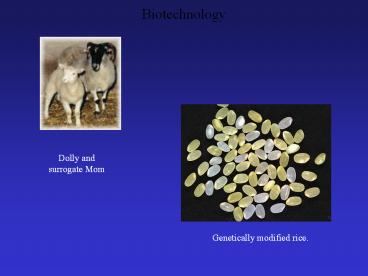Biotechnology - PowerPoint PPT Presentation
Title:
Biotechnology
Description:
Biotechnology Dolly and surrogate Mom Genetically modified rice. Biotechnology * G. Podgorksi, Biol. 1010 * Biotechnology * G. Podgorksi, Biol. 1010 * Biotechnology ... – PowerPoint PPT presentation
Number of Views:19
Avg rating:3.0/5.0
Title: Biotechnology
1
Biotechnology
Dolly and surrogate Mom
Genetically modified rice.
2
Biotechnology
Biotechnology, defined broadly, is the
engineering of organisms for useful purposes.
Often, biotechnology involves the creation of
hybrid genes and their introduction into
organisms in which some or all of the gene is not
normally present.
3
Biotechnology
Well examine
4
Recombinant DNA, Gene Cloning, and Pharmaceutical
Production
These are mature and widely utilized
biotechnologies.
DNA can be cut at specific sequences using
restriction enzymes.
This creates DNA fragments useful for gene
cloning.
5
Restriction Enzymes are Enzymes That Cut DNA Only
at Particular Sequences
Restriction enzyme animation
Different restriction enzymes have different
recognition sequences.
This makes it possible to create a wide variety
of different gene fragments.
6
DNAs Cut by a Restriction Enzyme Can be Joined
Together in New Ways
These are recombinant DNAs and they often are
made of DNAs from different organisms.
7
Plasmids are Used to Replicate a Recombinant DNA
Plasmids are small circles of DNA found in
bacteria.
Plasmids replicate independently of the bacterial
chromosome.
Pieces of foreign DNA can be added within a
plasmid to create a recombinant plasmid.
Replication often produces 50-100 copies of a
recombinant plasmid in each cell.
8
Harnessing the Power of Recombinant DNA
Technology Human Insulin Production by Bacteria
9
Human Insulin Production by Bacteria
10
Human Insulin Production by Bacteria
Screening bacterial cells to learn which contain
the human insulin gene is the hard part.
11
Route to the Production by Bacteria of Human
Insulin
This is the step when gene cloning takes place.
The single recombinant plasmid replicates within
a cell.
Then the single cell with many recombinant
plasmids produces trillions of like cells with
recombinant plasmid and the human insulin gene.
12
Route to the Production by Bacteria of Human
Insulin
The final steps are to collect the bacteria,
break open the cells, and purify the insulin
protein expressed from the recombinant human
insulin gene.
13
Route to the Production by Bacteria of Human
Insulin
Overview of gene cloning.
Cloning animation
14
Reverse transcription cDNA Cloning Suppose we
need to clone a gene containing lots of introns.
What will happen when the bacterium tries to
express it? To overcome this problem, we can
start with mRNA isolated from tissues that
produce the desired protein. We then use reverse
transcriptase enzyme (produced by a retrovirus
related to HIV) to reverse transcribe the mRNA
into a DNA molecule that now is free of introns.
Now we can ligate "sticky ends" onto the cDNA and
recombine it into a phage or plasmid vector. Or
Use Proteins sequence - BLAST website to get DNA
sequence and PCR to make multiple copies of cDNA
that can then be cloned.
15
(No Transcript)
16
DNA, the Law, and Many Other Applications The
Technology of DNA Fingerprinting
A DNA fingerprint used in a murder case.
The defendant stated that the blood on his
clothing was his.
What are we looking at? How was it produced?
17
DNA Fingerprinting Basics
Different individuals carry different alleles.
Most alleles useful for DNA fingerprinting differ
on the basis of the number of repetitive DNA
sequences they contain.
18
DNA Fingerprinting Basics
If DNA is cut with a restriction enzyme that
recognizes sites on either side of the region
that varies, DNA fragments of different sizes
will be produced.
A DNA fingerprint is made by analyzing the sizes
of DNA fragments produced from a number of
different sites in the genome that vary in
length.
The more common the length variation at a
particular site and the greater the number the
sites analyzed, the more informative the
fingerprint.
19
A Site With Three Alleles Useful for DNA
Fingerprinting
DNA fragments of different size will be produced
by a restriction enzyme that cuts at the points
shown by the arrows.
20
The DNA Fragments Are Separated on the Basis of
Size
The technique is gel electrophoresis.
The pattern of DNA bands is compared between each
sample loaded on the gel.
Gel electrophoresis animation
21
Possible Patterns for a Single Gene With Three
Alleles
In a standard DNA fingerprint, about a dozen
sites are analyzed, with each site having many
possible alleles.
22
A DNA Fingerprint
When many genes are analyzed, each with many
different alleles, the chance that two patterns
match by coincidence is vanishingly small.
Cloning animation
Cloning animation
Cloning animation
Cloning animation
Cloning animation
DNA detective animation
HGP fingerprinting page
23
DNA and the Law
Some applications of DNA fingerprinting in the
justice system.
24
Genetically Modified Foods
Many of our crops in the US are genetically
modified.
Should they be?
25
GM Crops are Here Today
Source Pew Initiative on Food and Biotechnology,
August 2004.
26
Methods for Plant Genetic Engineering are
Well-Developed and Similar to Those for Animals
27
Golden Rice is Modified to be Provide a Dietary
Source of Vitamin A
Worldwide, 7 of children suffer vitamin A
deficiency, many of them living in regions in
which rice is a staple of the diet.
28
Genetically Modified Crops
Genetically Modified Cotton (contains a
bacterial gene for pest resistance)
Standard Cotton
29
Current Concerns by Scientists Focus on
Environmental, Not Health, Effects of GM Crops
The jurys still out on the magnitude of GM
crops ecological impact, but the question is
debated seriously.
30
Current Concerns by Scientists Focus on
Environmental, Not Health, Effects of GM Crops































